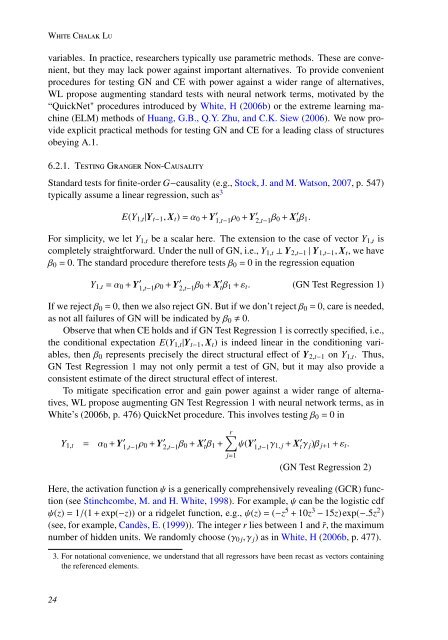Causality in Time Series - ClopiNet
Causality in Time Series - ClopiNet
Causality in Time Series - ClopiNet
Create successful ePaper yourself
Turn your PDF publications into a flip-book with our unique Google optimized e-Paper software.
White Chalak Luvariables. In practice, researchers typically use parametric methods. These are convenient,but they may lack power aga<strong>in</strong>st important alternatives. To provide convenientprocedures for test<strong>in</strong>g GN and CE with power aga<strong>in</strong>st a wider range of alternatives,WL propose augment<strong>in</strong>g standard tests with neural network terms, motivated by the“QuickNet" procedures <strong>in</strong>troduced by White, H (2006b) or the extreme learn<strong>in</strong>g mach<strong>in</strong>e(ELM) methods of Huang, G.B., Q.Y. Zhu, and C.K. Siew (2006). We now provideexplicit practical methods for test<strong>in</strong>g GN and CE for a lead<strong>in</strong>g class of structuresobey<strong>in</strong>g A.1.6.2.1. Test<strong>in</strong>g Granger Non-<strong>Causality</strong>Standard tests for f<strong>in</strong>ite-order G−causality (e.g., Stock, J. and M. Watson, 2007, p. 547)typically assume a l<strong>in</strong>ear regression, such as 3E(Y 1,t |Y t−1 , X t ) = α 0 + Y ′ 1,t−1 ρ 0 + Y ′ 2,t−1 β 0 + X ′ tβ 1 .For simplicity, we let Y 1,t be a scalar here. The extension to the case of vector Y 1,t iscompletely straightforward. Under the null of GN, i.e., Y 1,t ⊥ Y 2,t−1 | Y 1,t−1 , X t , we haveβ 0 = 0. The standard procedure therefore tests β 0 = 0 <strong>in</strong> the regression equationY 1,t = α 0 + Y ′ 1,t−1 ρ 0 + Y ′ 2,t−1 β 0 + X ′ tβ 1 + ε t . (GN Test Regression 1)If we reject β 0 = 0, then we also reject GN. But if we don’t reject β 0 = 0, care is needed,as not all failures of GN will be <strong>in</strong>dicated by β 0 0.Observe that when CE holds and if GN Test Regression 1 is correctly specified, i.e.,the conditional expectation E(Y 1,t |Y t−1 , X t ) is <strong>in</strong>deed l<strong>in</strong>ear <strong>in</strong> the condition<strong>in</strong>g variables,then β 0 represents precisely the direct structural effect of Y 2,t−1 on Y 1,t . Thus,GN Test Regression 1 may not only permit a test of GN, but it may also provide aconsistent estimate of the direct structural effect of <strong>in</strong>terest.To mitigate specification error and ga<strong>in</strong> power aga<strong>in</strong>st a wider range of alternatives,WL propose augment<strong>in</strong>g GN Test Regression 1 with neural network terms, as <strong>in</strong>White’s (2006b, p. 476) QuickNet procedure. This <strong>in</strong>volves test<strong>in</strong>g β 0 = 0 <strong>in</strong>Y 1,t = α 0 + Y ′ 1,t−1 ρ 0 + Y ′ 2,t−1 β 0 + X ′ tβ 1 +r∑︁ψ(Y ′ 1,t−1 γ 1, j + X ′ tγ j )β j+1 + ε t .j=1(GN Test Regression 2)Here, the activation function ψ is a generically comprehensively reveal<strong>in</strong>g (GCR) function(see St<strong>in</strong>chcombe, M. and H. White, 1998). For example, ψ can be the logistic cdfψ(z) = 1/(1 + exp(−z)) or a ridgelet function, e.g., ψ(z) = (−z 5 + 10z 3 − 15z)exp(−.5z 2 )(see, for example, Candès, E. (1999)). The <strong>in</strong>teger r lies between 1 and ¯r, the maximumnumber of hidden units. We randomly choose (γ 0 j ,γ j ) as <strong>in</strong> White, H (2006b, p. 477).3. For notational convenience, we understand that all regressors have been recast as vectors conta<strong>in</strong><strong>in</strong>gthe referenced elements.24





